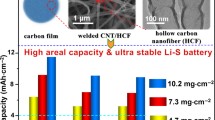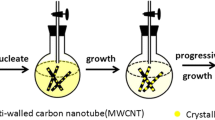Abstract
The structure of sulfur host materials plays a key role in alleviating the shuttle effect, volume expansion and sluggish redox reaction of lithium–sulfur batteries (LSBs). In this work, the well-designed multichannel carbon fibers decorated by carbon nanotubes (CNTs) and CoS nanoparticles (MCF/CoS/CNT) are synthesized and serve as the flexible sulfur host. The in situ grown CNTs network and embedded CoS enhance the overall conductivity of electrode and facilitate the redox reaction of sulfur-related electrochemistry. Benefitting from these merits, the MCF/CoS/CNT-based cathode exhibits a high reversible capacity of 927 mAh g−1 after 180 cycles with a low decay of 0.034% per cycle at 1.0 C. A superb areal capacity of 5.2 mAh cm−2 could be obtained under a high sulfur loading of 6.3 mg cm−2 and an ultralow electrolyte/sulfur ratio of 6.5 μL mg−1 after 100 cycles. This work offers a promising approach to the reasonable design of flexible sulfur host for LSBs toward high energy density.
Graphical abstract









Similar content being viewed by others
References
Hong X, Mei J, Wen L, Tong Y, Vasileff AJ, Wang L, Liang J, Sun Z, Dou SX. Nonlithium metal-sulfur batteries: steps toward a leap. Adv Mater 2019;31(5):1802822.
Larcher D, Tarascon JM. Towards greener and more sustainable batteries for electrical energy storage. Nat Chem 2015;7(1):19–29.
Tao T, Lu S, Fan Y, Lei W, Huang S, Chen Y. Anode improvement in rechargeable lithium–sulfur batteries. Adv Mater 2017;29(48):1700542.
Liang J, Sun ZH, Li F, Cheng HM. Carbon materials for Li–S batteries: functional evolution and performance improvement. Energy Stor Mater 2016;2:76–106.
Liu X, Huang JQ, Zhang Q, Mai L. Nanostructured metal oxides and sulfides for lithium–sulfur batteries. Adv Mater 2017;29(20):1601759.
Li GR, Chen ZW, Lu J. Lithium–sulfur batteries for commercial applications. Chem 2018;4(1):3–7.
Zhang R, Cheng XB, Zhao CZ, Peng HJ, Shi JL, Huang JQ, Wang J, Wei F, Zhang Q. Conductive nanostructured scaffolds render low local current density to inhibit lithium dendrite growth. Adv Mater 2016;28(11):2155–62.
Peng HJ, Huang JQ, Zhang Q. A review of flexible lithium–sulfur and analogous alkali metal-chalcogen rechargeable batteries. Chem Soc Rev 2017;46(17):5237–88.
Scott CD, Arepalli S, Nikolaev P, Smalley RE. Growth mechanisms for single-wall carbon nanotubes in a laser-ablation process. Appl Phys A 2001;72(5):573–80.
Huang A, Ma Y, Peng J, Li L, Chou S-L, Ramakrishna S, Peng S. Tailoring the structure of silicon-based materials for lithium-ion batteries via electrospinning technology. eScience 2021;1:141–62.
Liu M, Deng N, Ju J, Fan L, Wang L, Li Z, Zhao H, Yang G, Kang W, Yan J, Cheng B. A review: electrospun nanofiber materials for lithium–sulfur batteries. Adv Funct Mater 2019;29(49):1905467.
Gao Y, Guo Q, Zhang Q, Cui Y, Zheng Z. Fibrous materials for flexible Li–S battery. Adv Energy Mater 2020;11(15):2002580.
Tao X. Study of fiber-based wearable energy systems. Acc Chem Res 2019;52(2):307–15.
Yan W, Dong C, Xiang Y, Jiang S, Leber A, Loke G, Xu W, Hou C, Zhou S, Chen M, Hu R, Shum PP, Wei L, Jia X, Sorin F, Tao X, Tao G. Thermally drawn advanced functional fibers: new frontier of flexible electronics. Mater Today 2020;35:168–94.
Zheng M, Chi Y, Hu Q, Tang H, Jiang X, Zhang L, Zhang S, Pang H, Xu Q. Carbon nanotube-based materials for lithium–sulfur batteries. J Mater Chem A 2019;7(29):17204–41.
Fu A, Wang C, Pei F, Cui J, Fang X, Zheng N. Recent advances in hollow porous carbon materials for lithium–sulfur batteries. Small 2019;15(10):1804786.
Luo J, Liu HP, Guan KK, Lei W, Jia QL, Zhang SW, Zhang HJ. Cobalt nanoparticles decorated “wire in tube” famework as a multifunctional sulfur reservoir. ACS Sustain Chem Eng 2022;10:6117–27.
Ma Z, Liu Y, Gautam J, Liu W, Chishti AN, Gu J, Yang G, Wu Z, Xie J, Chen M, Ni L, Diao G. Embedding cobalt atom clusters in CNT-wired MoS2 tube-in-tube nanostructures with enhanced sulfur immobilization and catalyzation for Li–S batteries. Small 2021;17(39):2102710.
Lee JS, Kim W, Jang J, Manthiram A. Sulfur-embedded activated multichannel carbon nanofiber composites for long-life, high-rate lithium–sulfur batteries. Adv Energy Mater 2017;7(5):1601943.
Pan Y, Cheng X, Gao M, Fu Y, Feng J, Ahmed H, Gong L, Zhang H, Battaglia VS. Dual-functional multichannel carbon framework embedded with CoS2 nanoparticles: promoting the phase transformation for high-loading Li–S batteries. ACS Appl Mater Interfaces 2020;12(29):32726–35.
Zhou L, Danilov DL, Eichel RA, Notten PHL. Host materials anchoring polysulfides in Li–S batteries reviewed. Adv Energy Mater 2020;11(15):2001304.
Luo J, Guan K, Lei W, Zhang S, Jia Q, Zhang H. One dimensional carbon-based composites as cathodes for lithium–sulfur battery. J Mater Sci Technol 2022;122:101–20.
Philip P, Tomlal Jose E, Chacko JK, Philip KC, Thomas PC. Preparation and characterisation of surface roughened PMMA electrospun nanofibers from PEO-PMMA polymer blend nanofibers. Polym Test 2019;74:257–65.
Hu L, Yan X, Yao CG, Deng SY, Gao XM, Zhang XJ, Shan D. Preparation of amidoximated coaxial electrospun nanofibers for uranyl uptake and their electrochemical properties. Sep Purif Technol 2016;171:44–51.
Wang FF, Zhang HM, Wang Q, Fang CC, Zhang R, Wang P, Zhang Y. Preparation and characterization of AMT/Co(acac)3-loaded PAN/PS micro-nanofibers with large through-pores. Nanoscale Res Lett 2019;14(1):290.
Liu H, Lei W, Tong Z, Guan K, Jia Q, Zhang S, Zhang H. Enhanced diffusion kinetics of Li ions in double-shell hollow carbon fibers. ACS Appl Mater Interfaces 2021;13(21):24604–14.
Hong W, Zhang Y, Yang L, Tian Y, Ge P, Hu J, Wei W, Zou G, Hou H, Ji X. Carbon quantum dot micelles tailored hollow carbon anode for fast potassium and sodium storage. Nano Energy 2019;65:104038.
Ma L, Zhang W, Wang L, Hu Y, Zhu G, Wang Y, Chen R, Chen T, Tie Z, Liu J, Jin Z. Strong capillarity, chemisorption, and electrocatalytic capability of crisscrossed nanostraws enabled flexible, high-rate, and long-cycling lithium–sulfur batteries. ACS Nano 2018;12(5):4868–76.
Huang X, Tang JY, Luo B, Knibbe R, Lin TE, Hu H, Rana M, Hu YX, Zhu XB, Gu QF, Wang D, Wang LZ. Sandwich-like ultrathin TiS2 nanosheets confined within N, S codoped porous carbon as an effective polysulfide promoter in lithium–sulfur batteries. Adv Energy Mater 2019;9(32):1901872.
Liu Y, Zhang N, Jiao L, Chen J. Tin nanodots encapsulated in porous nitrogen-doped carbon nanofibers as a free-standing anode for advanced sodium-ion batteries. Adv Mater 2015;27(42):6702–7.
Gao C, Fang C, Zhao H, Yang J, Gu Z, Sun W, Zhang W, Li S, Xu L-C, Li X, Huo F. Rational design of multi-functional CoS@rGO composite for performance enhanced Li–S cathode. J Power Sourc 2019;421:132–8.
Wu DS, Shi F, Zhou G, Zu C, Liu C, Liu K, Liu Y, Wang J, Peng Y, Cui Y. Quantitative investigation of polysulfide adsorption capability of candidate materials for Li–S batteries. Energy Stor Mater 2018;13:241–6.
Zhang Y, Mu Z, Yang C, Xu Z, Zhang S, Zhang X, Li Y, Lai J, Sun Z, Yang Y, Chao Y, Li C, Ge X, Yang W, Guo S. Rational design of MXene/1T-2H MoS2-C nanohybrids for high-performance lithium–sulfur batteries. Adv Funct Mater 2018;28(38):1707578.
Seh ZW, Sun Y, Zhang Q, Cui Y. Designing high-energy lithium–sulfur batteries. Chem Soc Rev 2016;45(20):5605–34.
Li T, Bai X, Gulzar U, Bai YJ, Capiglia C, Deng W, Zhou X, Liu Z, Feng Z, Proietti ZR. A comprehensive understanding of lithium–sulfur battery technology. Adv Funct Mater 2019;29(32):1901730.
Wang M, Fan L, Tian D, Wu X, Qiu Y, Zhao C, Guan B, Wang Y, Zhang N, Sun K. Rational design of hierarchical SnO2/1T-MoS2 nanoarray electrode for ultralong-life Li–S batteries. ACS Energy Lett 2018;3(7):1627–33.
Ng SF, Lau MYL, Ong WJ. Lithium–sulfur battery cathode design: Tailoring metal-based nanostructures for robust polysulfide adsorption and catalytic conversion. Adv Mater 2021;33(50):2008654.
Long J, Zhang H, Ren J, Li J, Zhu M, Han T, Sun B, Zhu S, Zhang H, Liu J. A metal organic foam-derived multi-layered and porous copper sulfide scaffold as sulfur host with multiple shields for preventing shuttle effect in lithium–sulfur batteries. Electrochim Acta 2020;356(1):136853.
Lian X, Xu N, Ma Y, Hu F, Wei H, Chen H-Y, Wu Y, Li L, Li D, Peng S. In-situ formation of Co1-xS hollow polyhedrons anchored on multichannel carbon nanofibers as self-supporting anode for lithium/sodium-ion batteries. Chem Eng J 2021;421(2):127755.
Li Y, Xu P, Chen G, Mou J, Xue S, Li K, Zheng F, Dong Q, Hu J, Yang C, Liu M. Enhancing Li–S redox kinetics by fabrication of a three dimensional Co/CoP@nitrogen-doped carbon electrocatalyst. Chem Eng J 2020;380(15):122595.
Tao X, Wang J, Liu C, Wang H, Yao H, Zheng G, Seh ZW, Cai Q, Li W, Zhou G, Zu C, Cui Y. Balancing surface adsorption and diffusion of lithium-polysulfides on nonconductive oxides for lithium–sulfur battery design. Nat Commun 2016;7(1):11203.
Wu Q, Yao Z, Zhou X, Xu J, Cao F, Li C. Built-on catalysis in confined nanoreactors for high-loading Li–S batteries. ACS Nano 2020;14(3):3365–77.
Tong Z, Huang L, Lei W, Zhang H, Zhang S. Carbon-containing electrospun nanofibers for lithium–sulfur battery: current status and future directions. J Energy Chem 2021;54:254–73.
Tong Z, Huang L, Guo J, Gao Y, Zhang H, Jia Q, Luo D, Lei W, Zhang S. Simultaneously achieving fast sulfur redox kinetics and high-loading in lithium–sulfur batteries. Carbon 2022;187:451–61.
Ma F, Wan Y, Wang X, Wang X, Liang J, Miao Z, Wang T, Ma C, Lu G, Han J, Huang Y, Li Q. Bifunctional atomically dispersed Mo-N2/C nanosheets boost lithium sulfide deposition/decomposition for stable lithium–sulfur batteries. ACS Nano 2020;14(8):10115–26.
Zeng P, Yuan C, An J, Yang X, Cheng C, Yan T, Liu G, Chan T-S, Kang J, Zhang L, Sun X. Achieving reversible precipitation-decomposition of reactive Li2S towards high-areal-capacity lithium–sulfur batteries with a wide-temperature range. Energy Stor Mater 2022;44:432–5.
Huang J-Q, Zhang B, Xu Z-L, Abouali S, Akbari Garakani M, Huang J, Kim J-K. Novel interlayer made from Fe3C/carbon nanofiber webs for high performance lithium–sulfur batteries. J Power Sources 2015;285:43–50.
Pan H, Huang X, Wang C, Liu D, Wang D, Zhang R, Li S, Lv C, Zhao L, Wang J, Huang X. Sandwich structural TixOy–Ti3C2/C3N4 material for long life and fast kinetics lithium–sulfur battery: bidirectional adsorption promoting lithium polysulfide conversion. Chem Eng J 2021;410:128424.
Guo J, Jiang H, Li X, Chu Z, Zheng W, Dai Y, Jiang X, Wu X, He G. Defective graphene coating-induced exposed interfaces on CoS nanosheets for high redox electrocatalysis in lithium–sulfur batteries. Energy Stor Mater 2021;40:358–67.
Tong Z, Huang L, Liu H, Lei W, Zhang H, Zhang S, Jia Q. Defective graphitic carbon nitride modified separators with efficient polysulfide traps and catalytic sites for fast and reliable sulfur electrochemistry. Adv Funct Mater 2021;31(11):2010455.
Zhang L, Chen Z, Dongfang N, Li M, Diao C, Wu Q, Chi X, Jiang P, Zhao Z, Dong L, Che R, Loh KP, Lu H. Nickel-cobalt double hydroxide as a multifunctional mediator for ultrahigh-rate and ultralong-life Li–S batteries. Adv Energy Mater 2018;8(35):1802431.
Abdul Razzaq A, Yao YZ, Shah R, Qi PW, Miao LX, Chen MZ, Zhao XH, Peng Y, Deng Z. High-performance lithium sulfur batteries enabled by a synergy between sulfur and carbon nanotubes. Energy Stor Mater 2019;16:194–202.
Acknowledgements
This work was financially supported by National Natural Science Foundation of China (Grant Nos. 52104309 and 52072274). We also acknowledge the fund of Hubei Natural Science Foundation (2021CFB011) and the support of “Macao Young Scholars Program”, China (AM2020004).
Author information
Authors and Affiliations
Corresponding authors
Ethics declarations
Conflict of Interest
The authors state that there are no conflicts of interest to disclose.
Additional information
Publisher's Note
Springer Nature remains neutral with regard to jurisdictional claims in published maps and institutional affiliations.
Supplementary Information
Below is the link to the electronic supplementary material.
Rights and permissions
Springer Nature or its licensor holds exclusive rights to this article under a publishing agreement with the author(s) or other rightsholder(s); author self-archiving of the accepted manuscript version of this article is solely governed by the terms of such publishing agreement and applicable law.
About this article
Cite this article
Luo, J., Liu, X., Lei, W. et al. Self-Standing Lotus Root-Like Host Materials for High-Performance Lithium–Sulfur Batteries. Adv. Fiber Mater. 4, 1656–1668 (2022). https://doi.org/10.1007/s42765-022-00206-y
Received:
Accepted:
Published:
Issue Date:
DOI: https://doi.org/10.1007/s42765-022-00206-y




